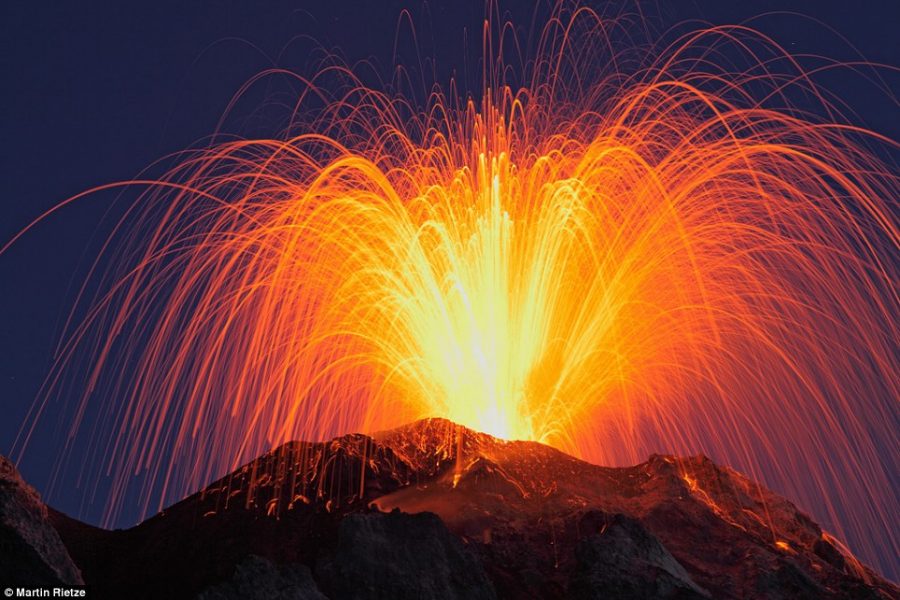Aloha State Finds Itself in a Hot Mess
June 3, 2018
On Thursday, May 3rd, Hawaii’s Big Island was hit hard by volcanic eruptions and massive lava spills. Streams of lava and ashes surrounded the island, putting residents in grave danger. This natural disaster goes by the name of Kilauea. The bright orange, boiling hot substance that spurts out of the top of Kilauea Volcano periodically has now left many residents without a home and forced locals to evacuate.
According to Live Science, Kilauea Volcano, Hawaii’s youngest, has been erupting since January 1983. Hawaii Center for Volcanology states that January 3rd marks the 35th year of Kilauea’s activity. The U.S. National Park Service designates Kilauea an active volcano, which means it has erupted in the last 200 years and will likely continue to erupt. Kilauea’s eruption on May 3rd released poisonous gases, ash, and pools of lava that flowed 250 yards before settling, as reported by NPR.
There are three significant factors which can lead to a volcanic eruption. “The first is that rocks inside the earth melt, forming magma, which has a greater volume than the original rock,” said Ms. Halliwell, an AP Environmental Science teacher at THS. “This increase in volume means that the magma is less dense than the rocks surrounding it, which causes it to rise up towards the surface and eventually erupt. The second cause for eruption has to do with the gases that are dissolved in the magma. Some of these gases—like water vapor and carbon dioxide—actually come out of solution as the magma rises and can lead to a more explosive eruption. The third cause would be a rapid movement of magma into a fissure that is already packed with some other material, forcing that material to erupt.”
Besides serious volcanic eruptions, the Big Island also experienced an earthquake on Saturday, May 12th. It reached a magnitude of 3.5, which is on the low side on the Richter scale, so it caused little destruction.
Due to the volcanic eruption, according to CNN, officials have handed out over 18,000 masks and recommend that people stay inside their homes, remain off the roads, and use the masks. While these masks protect people from most ashes, they don’t protect the locals from sulfur dioxide, a toxic gas. Most residents have been evacuated, as the sulfur dioxide in the air is extremely dangerous and can cause fatalities if inhaled. People can choke and have difficulty breathing when exposed to this poisonous gas. There are also other intoxicants that volcanoes release when they erupt. “In addition to lava and ash, many toxic gases are released into the atmosphere during an eruption, including hydrogen sulfide, hydrochloric acid, and sulfur dioxide,” said Halliwell.
Residents were advised by officials to evacuate the area as quickly as possible and to seek medical attention if affected by the toxic gas. According to NPR, respirators have even sold out in some stores on the island. Some residents, however, still refuse to leave. Scott Wiggers, a resident of Leilani Estates, said, “No one is forcibly evacuated. That’s why I am still here. They won’t come and drag us out of our homes; however, they don’t support what we’re doing. I’m talking about civil defense. They don’t agree with what we’re doing.”
The lava from the volcano has already engulfed 37 structures and counting, as reported by CNN. There is also a lasting concern regarding the possibility of phreatic eruptions, which occur when magma heats the ground or surface water, resulting in an explosion.
Thankfully, the government has taken action in assisting the people of Hawaii. NPR reported that President Trump has declared a federal emergency, allowing for federal assistance in the form of monetary aid. This financial aid will go towards fixing roads, schools, parks, and water pipes. Hopefully, it will allow residents of the island to return to the comfort of their communities sooner.



















































































































































